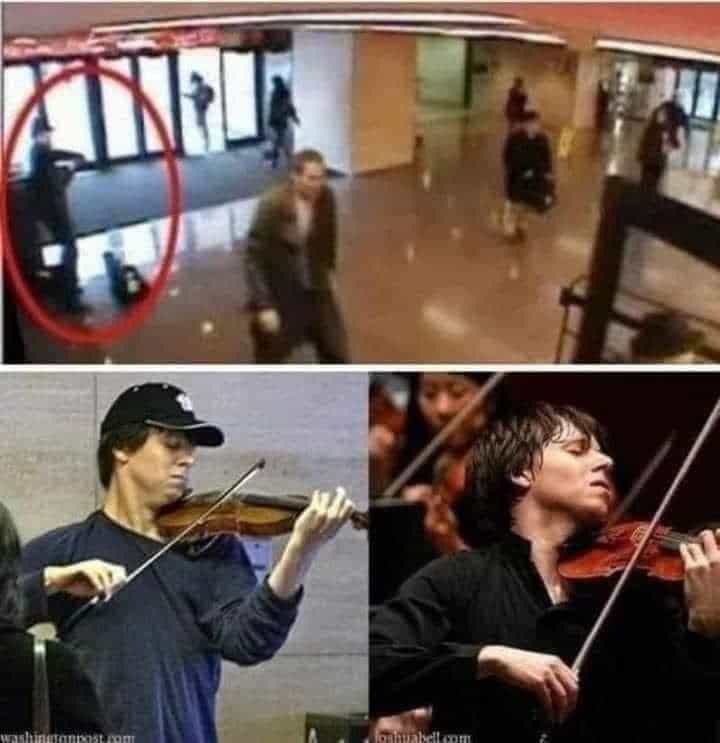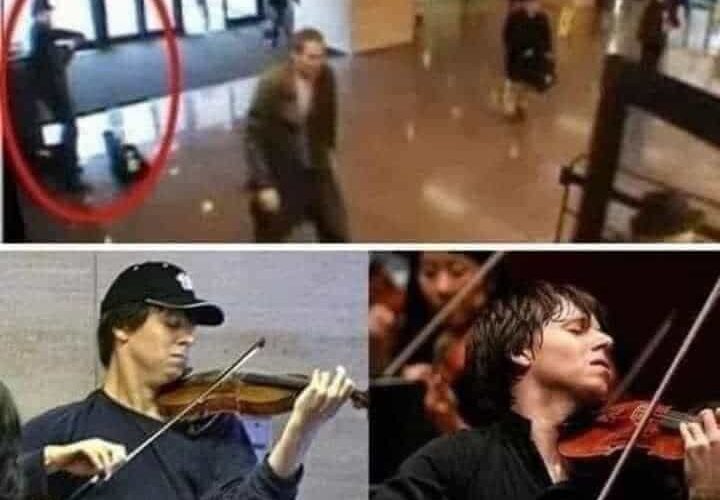Joshua Bell Experiment: What Happens When a Maestro Plays in the New York Subway?

Have you ever walked past something extraordinary without even noticing it? This is exactly what happened in a famous social experiment called the Joshua Bell Experiment.
It’s a story that makes us think about how we perceive beauty, talent, and the value of things in our busy lives. Let’s dive into this fascinating experiment and see what it teaches us.
What is the Joshua Bell Experiment?
The Joshua Bell Experiment took place on a cold morning in January 2007. Joshua Bell, one of the world’s most famous violinists, decided to perform incognito (in disguise) in a Washington, D.C. subway station. Dressed in casual clothes and a baseball cap, he played some of the most beautiful and complex pieces ever written for the violin. The violin he used was a Stradivarius, worth over $3.5 million. This experiment was organized by The Washington Post to see how people would react to world-class music in an unexpected place.
The Setup
Joshua Bell stood near a trash can in the L’Enfant Plaza subway station during the morning rush hour. For about 45 minutes, he played six classical pieces, including works by Bach and Schubert. The station was filled with the sounds of his violin, but most people were too busy to stop and listen. They were rushing to work, focused on their daily routines, and didn’t realize they were passing by a once-in-a-lifetime performance.
How Did People React?
Out of the thousands of people who passed by, only a handful stopped to listen. A few dropped some money into his violin case, but most didn’t even glance in his direction. In total, Bell collected about $32 from 27 passersby. This was a stark contrast to his usual performances, where people pay hundreds of dollars to hear him play in concert halls.
One of the most interesting moments was when a small crowd gathered to watch him play. But as soon as he finished the piece, they quickly dispersed, and the station returned to its usual hustle and bustle. Only one person recognized him—a woman who had seen him perform a few weeks earlier at a concert.
Why Did People Ignore Him?
The Joshua Bell Experiment raises an important question: Why did so many people ignore such incredible music? There are a few reasons:
Context Matters: People expect to hear world-class music in concert halls, not in subway stations. Because Bell was playing in an unexpected place, many didn’t realize the value of what they were hearing.
Busy Lives: During rush hour, most people are focused on getting to work or school. They’re in a hurry and don’t have time to stop and appreciate something unexpected, even if it’s extraordinary.
Perception of Value: When something is free or easily accessible, people often don’t value it as much. If Bell had been performing in a concert hall, people would have paid attention because they had paid for the experience.
Lack of Awareness: Many people simply didn’t recognize the music or the musician. Classical music isn’t as popular as other genres, so some passersby might not have understood the significance of what they were hearing.
What Does This Experiment Teach Us?
The Joshua Bell Experiment is more than just a story about a violinist playing in a subway station. It teaches us important lessons about life, perception, and the value we place on things.
Beauty is Everywhere, But We Often Miss It: Sometimes, the most beautiful things are right in front of us, but we’re too busy or distracted to notice. This experiment reminds us to slow down and appreciate the world around us.
Context Shapes Our Perception: Where and how we experience something can greatly influence how we perceive it. If Bell had been on a stage, people would have paid attention. But because he was in a subway station, they didn’t see the value in his performance.
Don’t Judge by Appearances: Joshua Bell was dressed like an ordinary street performer, so people didn’t realize he was a world-famous musician. This reminds us not to judge things or people based on their appearance.
The Importance of Mindfulness: The experiment highlights how often we go through life on autopilot, not fully aware of our surroundings. By being more mindful, we can notice and appreciate the extraordinary moments in everyday life.
The Impact of the Joshua Bell Experiment
The Joshua Bell Experiment became a global sensation after it was featured in The Washington Post. It sparked conversations about art, perception, and the way we value experiences. Many people were surprised by the results and began to reflect on their own lives. How often do they miss out on beautiful moments because they’re too busy or distracted?
The experiment also raised questions about the role of art in public spaces. Should there be more opportunities for people to experience world-class performances in everyday settings? Or do we only appreciate art when it’s presented in a formal context?
The Joshua Bell Experiment is a powerful reminder of how we perceive the world around us. It shows that beauty and talent can be found in the most unexpected places, but we often miss them because we’re too busy or distracted. By slowing down and being more mindful, we can learn to appreciate the extraordinary moments in everyday life.
So, the next time you’re rushing through your day, take a moment to stop and listen. You never know—you might just stumble upon something truly magical, like the sound of a world-class violinist playing in a subway station. And if you do, take the time to appreciate it. After all, life is full of beautiful moments—we just have to open our eyes and ears to see them.
FAQs About the Joshua Bell Experiment
1. What is the Joshua Bell Experiment?
The Joshua Bell Experiment was a social experiment conducted in 2007 by The Washington Post. World-famous violinist Joshua Bell performed incognito in a Washington, D.C. subway station during rush hour to see how people would react to his music in an unexpected setting.
2. Who is Joshua Bell?
Joshua Bell is one of the most celebrated violinists in the world. He has performed in prestigious concert halls and won numerous awards for his music. During the experiment, he played a Stradivarius violin worth over $3.5 million.
3. Where did the experiment take place?
The experiment took place at the L’Enfant Plaza subway station in Washington, D.C., on a cold January morning in 2007.
4. What did Joshua Bell play during the experiment?
Joshua Bell played six classical pieces, including works by famous composers like Bach and Schubert. These pieces are considered some of the most beautiful and challenging pieces ever written for the violin.
5. How did people react to Joshua Bell’s performance?
Out of thousands of people who passed by, only a few stopped to listen. Most were too busy or distracted to notice the world-class music. In total, Bell collected about $32 from 27 people, which was a stark contrast to the hundreds of dollars people usually pay to hear him perform in concert halls.
6. Why did so many people ignore Joshua Bell’s performance?
There are several reasons:
- Context: People don’t expect to hear world-class music in a subway station.
- Busy Lives: During rush hour, most people were focused on getting to work or school.
- Perception of Value: When something is free or easily accessible, people often don’t value it as much.
- Lack of Awareness: Many people didn’t recognize the music or the musician.
7. Did anyone recognize Joshua Bell during the experiment?
Yes, only one person recognized him—a woman who had seen him perform at a concert a few weeks earlier.
8. What was the purpose of the Joshua Bell Experiment?
The experiment aimed to explore how people perceive beauty and talent in unexpected places. It also raised questions about whether we value art differently depending on the context in which it is presented.
9. What lessons can we learn from the Joshua Bell Experiment?
The experiment teaches us to:
- Slow down and appreciate the beauty around us.
- Be open to unexpected experiences.
- Avoid judging things or people based on appearances.
- Value experiences over material possessions.
10. How did the Joshua Bell Experiment become famous?
The experiment gained widespread attention after it was featured in The Washington Post. The story went viral, sparking discussions about art, perception, and the value we place on experiences.
11. What does the Joshua Bell Experiment say about society?
The experiment highlights how often we go through life on autopilot, missing out on extraordinary moments because we’re too busy or distracted. It also shows how context and perception influence the way we value art and experiences.
12. Can I watch Joshua Bell’s subway performance?
Yes, parts of Joshua Bell’s subway performance were recorded and are available online. You can find videos on platforms like YouTube to see how the experiment unfolded.
13. Has the Joshua Bell Experiment been repeated?
While the original experiment hasn’t been officially repeated, it has inspired similar social experiments and discussions about art in public spaces.
14. What is the significance of the Stradivarius violin in the experiment?
The Stradivarius violin is one of the most valuable and finely crafted instruments in the world. Its use in the experiment highlights the contrast between the extraordinary quality of the performance and the ordinary setting of a subway station.
15. How can I apply the lessons of the Joshua Bell Experiment to my life?
You can:
- Take time to notice and appreciate the beauty in everyday life.
- Be open to unexpected opportunities and experiences.
- Encourage others to slow down and enjoy the moment.
- Support art and music in public spaces to make them more accessible to everyone.

